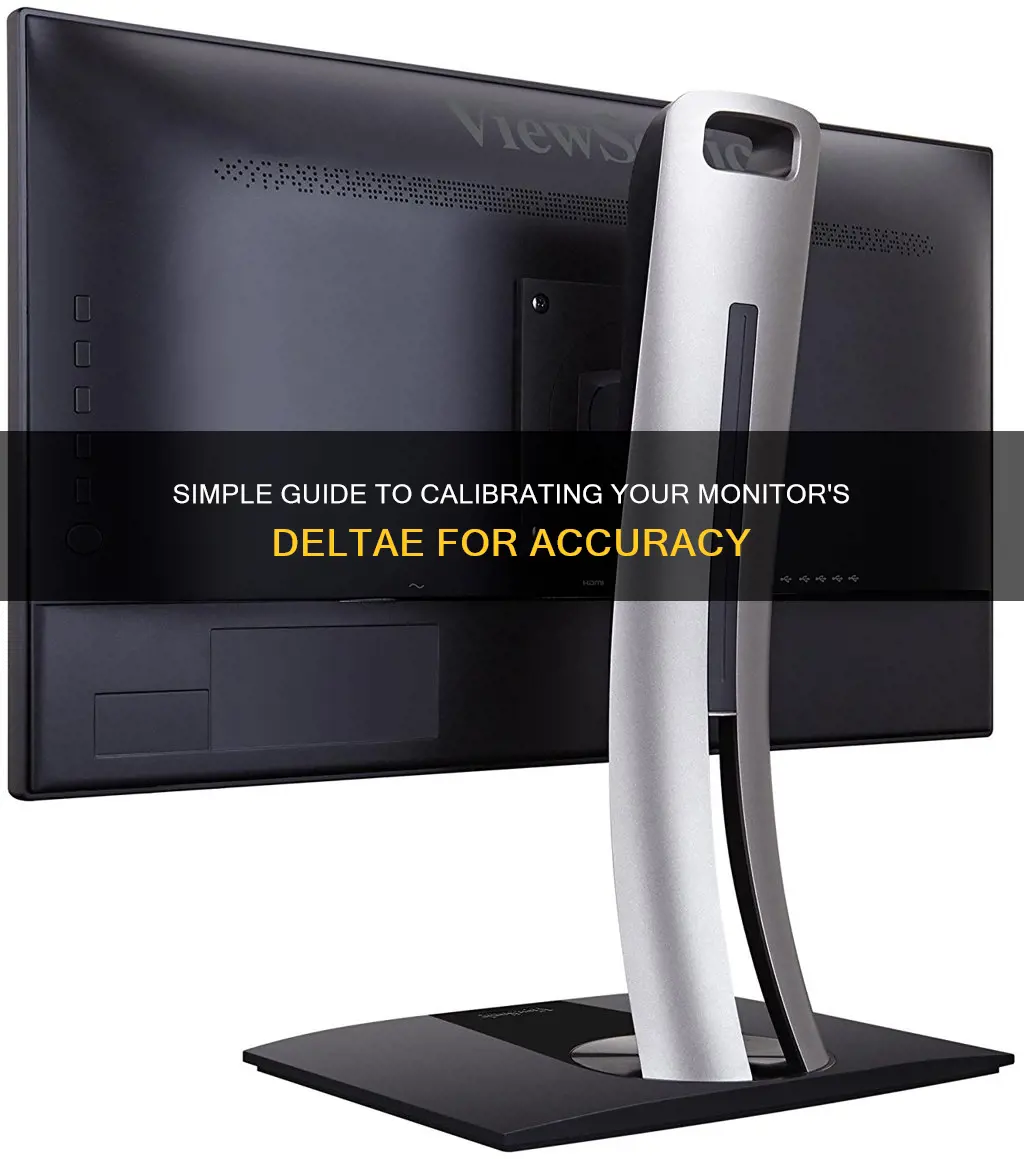
Calibration is the process of adjusting your monitor's settings to achieve accurate colour representation. DeltaE (dE) is a measurement of the amount of change in visual perception between two colours. It is an important metric for professionals who require colour accuracy, such as photographers and designers. Calibration tools, such as a tristimulus colorimeter, can be used to adjust monitor settings and generate a software-based calibration profile (ICC profile) to match an absolute reference. While this method is accurate, it requires a significant investment in equipment and software, or the hiring of a professional calibrator.
However, basic test patterns can also be used to enhance picture quality and create a more balanced image. Adjusting the brightness, contrast, and gamma settings can improve shadow detail and overall image contrast. Additionally, the backlight' setting can be changed to alter the amount of light output by the monitor, making it appear brighter. It is also important to consider the ambient light in the room when calibrating, as it can affect the way colours look on the screen.
For those seeking a more advanced calibration, there are software solutions such as DisplayMate and Spears and Munsil's UHD HDR Benchmark, which offer test patterns and instructions to fine-tune monitor settings. Hardware calibration tools, such as colorimeters, can also be used in conjunction with software to create multiple calibration profiles for different lighting conditions.
What You'll Learn
- Delta E (dE) measures the amount of change in visual perception of two colours
- The average person won't notice a Delta E error that's less than 3
- The trained eye can see down to errors of 1, while errors less than 1 are usually considered imperceptible
- Top monitors achieve a Delta E of 2, where the colour difference is barely detectable
- A Delta E number represents the mathematical difference between a colour input and the CIE standard

Delta E (dE) measures the amount of change in visual perception of two colours
Delta E (dE) is a standard measurement that quantifies the difference between two colours that appear on a screen. It was created by the International Commission on Illumination (CIE) to help professionals make informed decisions when purchasing colour-accurate monitors.
Delta E is measured on a scale from 0 to 100, where 0 indicates no colour difference and 100 indicates complete distortion. The closer to 0 the Delta E measurement is, the better the colour accuracy of a monitor, as there is less difference between colours.
The term Delta E means a difference in sensation or, in relation to colours, the difference in colours. Delta is the Greek term for an incremental change in a variable, and the E stands for Empfindung, which is German for sensation.
Delta E is important for colour accuracy. Even if a professional monitor covers high percentages of colour spaces like Adobe RGB, sRGB, and DCI-P3, a Delta E range above 3 means your work won't be colour accurate due to an incorrect colour display. For editing graphics, images, and videos, a Delta E of ≤3 will ensure no visible distortion in the colours as the human eye can see the displayed colours accurately.
The Delta E value can be determined with a complex equation, hardware calibrating your monitor, or provided in a factory calibration report.
When shopping for a monitor, you will want to purchase devices with Delta E levels that are less than two, as at that point, the human eye sees the displayed colours as they were originally intended to be shown. Top-of-the-line displays will have Delta E levels of one or less.
Delta E is calculated using delta L*, delta a*, and delta b* colour values, which provide a complete numerical descriptor of the colour in a rectangular coordinate system. The higher the value, the greater the difference in that dimension.
To calculate Delta E, you square the difference between each of the L, a, and b values, then add them together, and then take the square root of the sum.
Small differences can have a great impact on the Delta E. A Delta E of 1 may be perceptible by some with close inspection, while a Delta E of 5 may be noticeable at a glance.
Theatre Mode: ASUS Monitor's Unique Feature Explained
You may want to see also

The average person won't notice a Delta E error that's less than 3
Delta E (dE) is a standard measurement that evaluates and quantifies the difference between the colors that appear on your monitor. It was created by the International Commission on Illumination (CIE) to help professionals make informed decisions when purchasing color-accurate monitors.
Delta E is measured on a scale from 0 to 100, where 0 is less color difference, and 100 indicates complete distortion. The closer to 0 the Delta E measurement is, the better the color accuracy on a monitor. While the full scale is 0 to 100, if the range on a monitor is above 3, the differences will be clear, and your work will not be color accurate.
That said, the average person won't notice a Delta E error that's less than 3. Trained professionals, on the other hand, can see down to errors of 1, while errors less than 1 are usually considered imperceptible. Top monitors achieve a Delta E of 2, where the color difference is barely detectable.
Delta E is especially important for creative professionals who need to make sure that the colors they see on their screen are as true-to-life as possible. For instance, photographers, video editors, and graphic designers need to understand the meaning of Delta E as it's an essential part of choosing a professional-grade monitor. With a lower Delta E value, input, like from a camera, will be more accurate. It's also helpful for those using multiple monitors.
Delta E is also important for professionals who perform high-end tasks such as editing graphics and videos across multiple monitors without any noticeable distortion.
How do you determine the Delta E value? The Delta E value can be determined with a complex equation, hardware calibrating your monitor, or provided in a factory calibration report. Professional-grade monitors usually come with a factory calibration report that displays the exact color gamuts and Delta E specifications of that monitor.
Delta E is a metric for understanding how the human eye perceives color difference. The term delta comes from mathematics, meaning change in a variable or function. The suffix E references the German word "Empfindung", which broadly means sensation.
Delta E is also known as Delta E 2000, or dE2000 for short. This is the most recent formula, which was last updated in 2000.
Monitors with 17-inch Displays: Are They All Uniform in Size?
You may want to see also

The trained eye can see down to errors of 1, while errors less than 1 are usually considered imperceptible
Delta E (or dE) is a measurement of the amount of change in visual perception between two colours. It is a valuable tool for determining how colour-accurate a display is. Delta E is measured on a scale of 1-100, with a lower Delta E value indicating a more accurate colour reproduction.
The average person will not be able to perceive a Delta E error of less than 3. However, those with a trained eye, such as creative professionals, can detect errors as low as 1. Errors below 1 are generally considered imperceptible. Top-performing monitors can achieve a Delta E of 2, where the colour difference is barely detectable.
Delta E is calculated based on the standard test patch set, which consists of 39 unique test colours. It is used to evaluate the accuracy of colours, especially for professionals and creatives who depend on colour accuracy.
Delta E values are also used to test grayscale tracking. A Delta E of 3, for example, indicates that any bar extending above that value on a graph has visible errors.
LCD vs LED Monitors: Which Display Technology is Better?
You may want to see also

Top monitors achieve a Delta E of 2, where the colour difference is barely detectable
Delta E (dE) is a standard measurement that evaluates and quantifies the difference between the colours that appear on your monitor. It was created by the International Commission on Illumination (CIE) to help professionals make informed decisions when purchasing colour-accurate monitors. The closer to 0 the Delta E measurement is, the better the colour accuracy of a monitor, as there are fewer differences between colours.
While the full Delta E scale is 0 to 100, if the range on a monitor is above 3, the differences will be clear, and your work will not be colour accurate. The average person won't notice a Delta E error that's less than 3. However, the trained eye can see down to errors of 1, and errors less than 1 are usually considered imperceptible. Top monitors achieve a Delta E of 2, where the colour difference is barely detectable.
Delta E is especially important for creative professionals who need to make sure that the colours they see on their screen are as true-to-life as possible. With a lower Delta E value, input from a camera, for example, will be more accurate. It's also helpful for those using multiple monitors, as it ensures consistency across displays.
Delta E is calculated using a complex equation, hardware calibration, or a factory calibration report. Professional-grade monitors, such as the BenQ PD series for designers and SW series for photographers, come with a factory calibration report that displays the exact colour gamuts and Delta E specifications of that monitor.
To summarise, Delta E is a critical factor when selecting a monitor, especially for professionals and creatives who depend on colour accuracy. A Delta E of 2 or lower ensures barely detectable colour differences, making it ideal for those seeking true-to-life colour representation on their displays.
Replacement Power Supply for Acer Monitors: Where to Buy?
You may want to see also

A Delta E number represents the mathematical difference between a colour input and the CIE standard
Delta E (dE) is a measurement of the amount of change in visual perception between two colours. It provides valuable insight into how colour-accurate a display is. A Delta E number represents the mathematical difference between a colour input and the standard set by the International Commission on Illumination (CIE).
The CIE was founded in 1913 to standardise colourimetry, photometry and imaging. In 1974, they created the first algorithm to standardise colour difference. The most recent formula, updated in 2000, is called Delta E 2000, or dE2000.
Delta E values are especially important to professionals and creatives who rely on colour accuracy. Photographers, video editors and graphic designers, for example, need to ensure that the colours they see on their screens are true-to-life. Lower Delta E values mean more accurate colour and grayscale tracking.
Delta E is measured on a scale from 0 to 100. A Delta E of 0 means the colours are the same, while a Delta E of 100 means they are considered opposite colours. A Delta E error of less than 3 is typically imperceptible to the average person, but those with a trained eye can detect errors as low as 1. Top monitors can achieve a Delta E of 2, where the colour difference is barely detectable.
Delta E levels are the difference between the displayed colour and the original colour standard of the input content. A lower Delta E indicates greater accuracy, while a high Delta E indicates a significant mismatch.
Delta E is calculated using delta L*, delta a*, and delta b* colour values, which provide a complete numerical descriptor of the colour in a rectangular coordinate system.
DL* represents the difference in lightness between the sample and standard colours. da* represents the difference in redness or greyness, and db* represents the difference in blueness or yellowness.
When calibrating a monitor, it is important to consider various settings such as brightness, contrast, sharpness, colour temperature, and white balance. While some of these settings can be adjusted by eye, others require dedicated calibration tools and software to ensure accuracy.
VOC Monitor Calibration: Steps for Accurate Readings
You may want to see also
Frequently asked questions
It is recommended to calibrate your monitor once every two weeks or at least once per month for the best performance.
Delta E (dE) measures the amount of change in visual perception of two colours. This measurement provides valuable insight into how colour-accurate a display is. A Delta E of less than 3 is considered accurate, with the best monitors achieving a Delta E of 2.
DisplayCal is a popular and highly-regarded software for monitor calibration. It is free to use and provides detailed documentation on how to calibrate your monitor.







